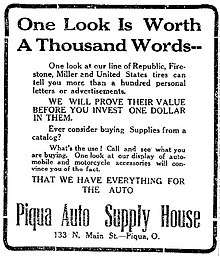A picture is worth a thousand words
"A picture is worth a thousand words" is an English language adage meaning that complex and sometimes multiple ideas[1] can be conveyed by a single still image, which conveys its meaning or essence more effectively than a mere verbal description.

History
Henrik Ibsen first said "A thousand words leave not the same deep impression as does a single deed." After his death in 1906 this quote was plagiarized and para-phrased into what we know now. In March 1911, the Syracuse Advertising Men's Club held a banquet to discuss journalism and publicity. In an article on The Post-Standard covering this event, the author quoted Tess Flanders as saying: "Use a picture. It's worth a thousand words." [2]
A similar phrase, "One Look Is Worth A Thousand Words", appears in a 1913 newspaper advertisement for the Piqua Auto Supply House of Piqua, Ohio.[3]
Early use of the exact phrase appears in a 1918 newspaper advertisement for the San Antonio Light, which says:
One of the Nation's Greatest Editors Says:
One Picture is Worth a Thousand Words
The San Antonio Light's Pictorial Magazine of the War
Exemplifies the truth of the above statement—judging from the warmreception it has received at the hands of the Sunday Light readers.[4]
The modern use of the phrase is generally attributed to Fred R. Barnard. Barnard wrote this phrase in the advertising trade journal Printers' Ink, promoting the use of images in advertisements that appeared on the sides of streetcars.[5] The December 8, 1921, issue carries an ad entitled, "One Look is Worth A Thousand Words." Another ad by Barnard appears in the March 10, 1927, issue with the phrase "One Picture Worth Ten Thousand Words", where it is labeled a Chinese proverb. The 1949 Home Book of Proverbs, Maxims, and Familiar Phrases quotes Barnard as saying he called it "a Chinese proverb, so that people would take it seriously."[6] Nonetheless, the proverb soon after became popularly attributed to Confucius. The actual Chinese expression "Hearing something a hundred times isn't better than seeing it once" (百闻不如一见, p bǎi wén bù rú yī jiàn) is sometimes introduced as an equivalent, as Watts's "One showing is worth a hundred sayings".[7] This was published as early as 1966 discussing persuasion and selling in a book on engineering design.[8]
Equivalents
Despite this modern origin of the popular phrase, the sentiment has been expressed by earlier writers. For example, Leonardo da Vinci wrote that a poet would be "overcome by sleep and hunger before [being able to] describe with words what a painter is able to [depict] in an instant."[9] The Russian writer Ivan Turgenev wrote in 1861, "The drawing shows me at one glance what might be spread over ten pages in a book."[10] The quote is sometimes attributed to Napoleon Bonaparte, who said "A good sketch is better than a long speech" (French: Un bon croquis vaut mieux qu'un long discours). This is sometimes translated today as "A picture is worth a thousand words."
Spoofed
The phrase has been spoofed by computer scientist John McCarthy, to make the opposite point: "As the Chinese say, 1001 words is worth more than a picture."[11]
See also
References
- cf Just a Minute
- "Speakers Give Sound Advice". Syracuse Post Standard. March 28, 1911. p. 18.
- "One Look Is Worth A Thousand Words". Piqua Leader-Dispatch. August 15, 1913. p. 2.
- "Pictorial Magazine of the War (advertisement)". San Antonio Light. January 10, 1918. p. 6.
- "The history of a picture's worth". Retrieved July 12, 2008.
- Stevenson, Burton (1949). Stevenson’s book of proverbs, maxims and familiar phrases. London: Routledge and Kegan Paul. p. 2611.
Quoted from Ole Bjørn Rekdal (2014). "Academic Citation Practice: A Sinking Sheep?" (PDF). portal: Libraries and the Academy. Johns Hopkins University Press. 14 (4): 575, 577, 578, 584.
see also "The history of a picture's worth". uregina.ca. Retrieved November 6, 2016.contains pictures and transcriptions of the original ads
- Watts, Alan. "The Way of Zen"
- Woodson, Thomas T. (1966) Introduction to Engineering Design. McGraw-Hill Technology & Engineering – 434 pages
- Janson, H.W.; Janson, Anthony (2001) [1962]. History of Art (6th ed.). Abrams Books. p. 613. ISBN 0810934469.
- Turgenev, Ivan. "16". Fathers and Sons. Retrieved September 29, 2015.
- McCarthy, John (March 1, 2007). "The sayings of John McCarthy". Archived from the original on October 14, 2007. Retrieved November 9, 2007.
Sources
- The Dictionary of Clichés by James Rogers (Ballantine Books, New York, 1985).
Further reading
- King, David (October 15, 1997). The Commissar Vanishes: The Falsification of Photographs and Art in Stalin's Russia (1 ed.). New York, NY: Metropolitan Books. ISBN 0805052941. Retrieved December 22, 2016.